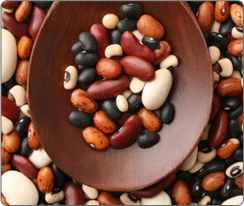Why Fiber is So Important for Good Health
Have you ever been told to increase your fiber intake or consume more high fiber foods? If so, you are probably wondering why, how to increase fiber and what a high fiber diet really looks like.
What is Fiber?
Fiber is a compound found only in plant foods. The human body can’t digest dietary fiber but it is a very important part of a healthy diet. Dietary fiber provides bulk to your diet, which will help you feel full thereby aiding in weight control. In addition, fiber helps prevent constipation by moving food through the intestines. And finally, fiber can help lower cholesterol.

Legumes are one source of soluble fiber.
Types of Fiber
There are two types of fiber found in your food, soluble and insoluble:
- Soluble fiber mixes with liquid during digestion forming a gel in the intestines. This process slows the movement of food through your intestinal tract keeping you full, keeping your blood sugar levels stable and helping lower blood cholesterol. Lowering cholesterol can help decrease one’s risk of developing heart disease, the number one cause of death for both men and women in the United States. Foods rich in soluble fiber include oat bran, barley, nuts, seeds, lentils, beans, peas and some fruits and vegetables.
- Insoluble fiber provides bulk to the diet. It passes through the intestines virtually unchanged and is primarily responsible for helping prevent and relieve constipation.
How Much Fiber and Where Do You Get it?
According to the 2010 Dietary Guidelines for Americans, the Adequate Intake for fiber is 14 grams per 1,000 calories or 25 grams per day for women and 38 grams per day for men. However, the average American gets roughly half the fiber they need for good health – only 15 grams of fiber per day.
The best way to increase your fiber intake is to consume more fiber-rich foods such as beans, peas, vegetables, fruits, whole grains and nuts. But, do so slowly over the course of time and drink plenty of fluids to help fiber pass through your digestive system. Increasing fiber intake rapidly in a short period of time can result in gas, bloating and stomach cramps.

Fiber needs water to move
through your system.
Fiber Supplements
If your diet falls short on fiber, should you supplement with fiber? Possibly. Taking insoluble fiber in the form of a supplement may help improve laxation thereby relieving constipation. And, taking a soluble fiber supplement or functional food with added soluble fiber can help lower high blood cholesterol in some people.
Tips to Increase Your Fiber Intake
- Eat at least one fruit or vegetable with every meal and snack.
- Add frozen or fresh vegetables to soups, casseroles and a variety of other dishes including omelets, pizza, lasagna and meatloaf.
- Snack on high fiber foods including vegetables, fruits and nuts.
- Top your cereal or yogurt with fresh fruit.
- Add frozen berries to a protein shake for a thick, delicious meal or snack.
- Try a new vegetable-based dish every time you dine out.
- Choose restaurants with salad bars that include a variety of fruits, vegetables, nuts and seeds.
- Talk to a registered dietitian about supplementing with fiber.
Increasing your dietary fiber intake to meet the recommended intake of 14 grams of fiber per every 1,000 calories of food you consume may improve your health. Fiber plays an important role in weight management. Studies show that eating foods high in fiber can keep you full and, studies show that fiber intake is inversely associated with body weight and body fat. In addition, dietary fiber may help lower your blood cholesterol levels, a risk factor for cardiovascular disease. And finally, dietary fiber, notably insoluble fiber, can help relieve constipation.
1 Dietary Fiber. Medline Plus, National Institutes of Health. February 2011.
http://www.nlm.nih.gov/medlineplus/ency/article/002470.htm Accessed February 20, 2011.
2 Weickert, M.O. and A.F. Pfeiffer. (2008). Metabolic effects of dietary fiber consumption and prevention of diabetes. J Nutr, 138, 439-42.
3 Heart Disease Statistics and Facts. Centers for Disease Control and Prevention. 2009.
http://www.cdc.gov/heartdisease/statistics.htm Accessed March 3, 2011.
4 U.S. Department of Agriculture and U.S. Department of Health and Human Services. Dietary Guidelines for Americans, 2010. 7th Edition, Washington, DC: U.S. Government Printing Office, December 2010. http://www.health.gov/dietaryguidelines/dga2010/DietaryGuidelines2010.pdf Accessed February 21, 2011.
5 Anderson, J.W., Baird, P., Davis, R.H., Ferreri, S. Knudtson, M., Koraym, A., Waters, V. and C.L. Williams. (2009). Health benefits of dietary fiber. Nutrition Reviews, 67, 188-205.
6 Castro, I.A., Barroso, L.P. and P. Sinnecker. (2005). Functional foods for coronary heart disease risk reduction: a meta-analysis using a multivariate approach. American Journal of Clinical Nutrition, 82;32-40.
7 Slavin, J.L. Dietary fiber and body weight. (2005). Nutrition 21, 411-8.

